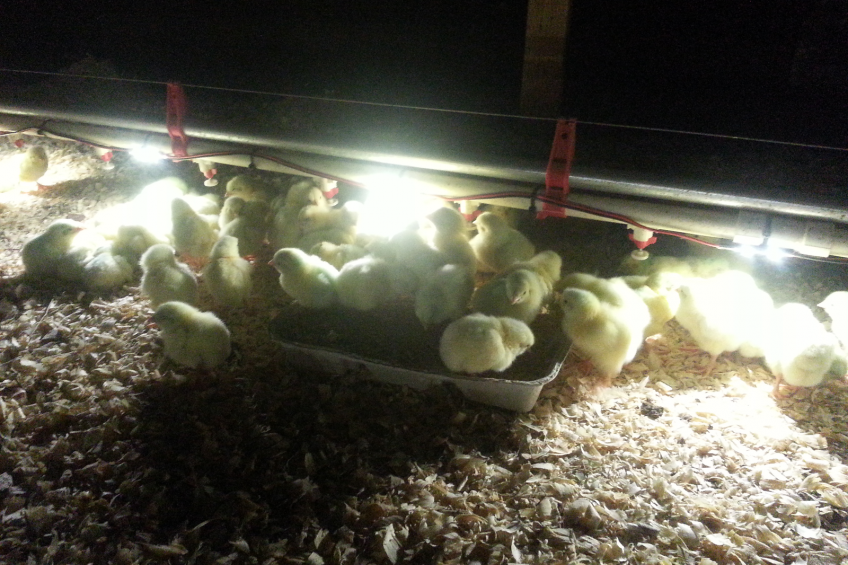Improved water and feed consumption with LED lighting

Based on field poultry research, feeder lights, in conjunction with water lights, will help birds reach their genetic potential by significantly improving both feed and water consumption. This includes increased 7-day, 21-day and market body weights, as well as an improved market-age body weight uniformity.
While the eco-friendly benefits of LED lighting are well documented, the agriculture industry has been slow to transition from CFLs and incandescent bulbs for numerous reasons. The low intensity of LEDs when mounted on an 8-9’ high ceiling has been cited as a potential cause for poor live performance in poultry. As a result, it’s essential for poultry rearing facility managers to understand how low light intensity negatively impacts bird behaviour and animal welfare before disregarding the adoption of new LED technologies.
Current lighting problems
Modern, high-efficiency broiler and turkey production employs 20-24 hours of high light intensity (generally 30 to 40 lx or 3-4fc) per day for the first week. Recent lighting trends strive to distribute 4+ foot candles (fc) throughout the entire brooding area, resulting in the needless spread of birds into areas without feed and water. Obtaining a consistent 4fc light across an entire house has been difficult with the use of low-intensity LEDs. Consequently, the poultry industry is now routinely using 23-55W CFLs during the first 5 to 7 days of life, then switching to LEDs from day eight to market.
For decades, live poultry production staff and animal welfare personnel considered LED lighting and the handling of complete dark-out housing—where a circadian rhythm via artificial lighting is essential for live performance. As early as 1984, researchers demonstrated that high light intensity (86 lx or 8.6 fc) allowed the maximum expression of genetic growth potential, especially in a low population bird density, as compared with 5.4 lx light intensity.
Modern research now confirms that high light intensity used during a typical 24-hr period and not photoperiod is the dominating factor in bird behaviour. Most researchers now conclude that broiler chickens prefer light intensity higher than 40 lx or 4 fc when active, but less than 5 lx or 0.5 fc when resting.
Providing a clear choice between light and dark, with distinct, contrasting differences, has been deemed humane. Research by Blatchford concluded that rearing broilers in very dim light (such as <5 lx or 0.50 fc) has adverse effects on animal welfare, such as larger, heavier eyes, diminished activity and increased lameness. Subsequently, international humane associations have indicated that four to six hours of darkness (over a 24-hour period) is essential for animal welfare.
Birds prefer to have high light intensity when active, and low light intensity when resting.
After extensive trials, Blatchford’s results indicated that light intensity has a stronger effect on bird behaviour, increasing bird activity and performance, than light duration. Birds prefer to have high light intensity when active and low light intensity when resting. For a bird to change behaviour, these researchers found that a contrast of at least 80 lx or 8 fc of change, with more substantial results deriving from contrasts of 180 lx (18 fc), were required. Finally, a comparison of low light (1 lx) with high light (200 lx) showed that birds reared in a high light environment (200 lx or 20 fc) developed a stronger circadian rhythm, have stronger and more healthy eye development, and develop fewer cases of lameness. Thus making birds eat, drink, move and then rest all in a healthy 24-hour cycle. This is in contrast with a small change in light (1 lx and 0.5 lx), in which they exhibited weaker circadian rhythms. The poultry industry has addressed these weak-light issues by increasing light intensity throughout the entire house, which also increases energy costs. High light intensity is commonly achieved by employing high powered ceiling LEDs (A-19, 8W or more), in conjunction with 23-55W CFLs or incandescent bulbs.
Lighting and water consumption pattern
Troubling water consumption patterns and the ability of chicks and poults to initiate water consumption is an ongoing discussion. Camera imaging and spatial analysis software have shown that, for the first 24-hr post-hatch, only 5% of young birds gather around the nipple drinkers at any point in time. Consequently, <25% of the birds are meeting their minimum hydration requirements.
Research conducted by AHPharma also indicated that >8fc of light at the feeder, with less light toward water nipples, attracted the majority of birds to the feed troughs and not to water nipple areas; thus causing the birds to have a reduced water:feed ratio. To correct this water consumption issue, LED Water Lights are being placed around nipple drinkers, yielding a highly significant >90% bird presence. Consequently, the high intensity water light source will increase the water:feed ratio—which is especially important from the time of placement up to 48hrs.
In response, AHPharma, in conjunction with poultry and LED manufacturing industry partners, recently pioneered the development of a high intensity LED light that provides >150 lx (or 15fc) installed conveniently over feeder pans—closer to the birds. The new feeder lights attracted an average of 88% of the flock around the feed/water areas during the first 10 days of life vs. conventional 55W CFL brooding lights (55% of the flock).
Using AviLighting water lights for the first 48 hours, followed by both feeder and water lights for the next 48 hours, resulted in >90% of young birds gathering around the nipple drinkers for the first 48 hours, then birds moved between watering and feeding for the 49-96 hour period. Consequently, birds ate 3.5% more feed, obtained 3% heavier 7-day weights and grew in a more consistent manner—resulting in 3% tighter body weight uniformity than birds reared in a facility with standard ceiling fixtures.













